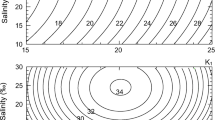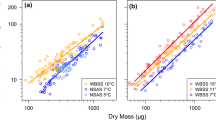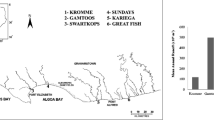Abstract
Nutritional indices were used to develop biochemical correlates of feeding and growth rates for juvenile summer flounder, Paralichthys dentatus (Linnaeus), from North Carolina (NC) and Delaware (DE). Six parameters (Fulton's condition K=104xweight/(length3), wet weight/dry weight, [protein], [RNA], [DNA], and RNA:DNA) were related to feeding and growth rates of fish from previously reported 10 to 14-d experiments at temperatures ranging from 2 to 20 °C with varying feeding levels (0 to 100% and libitum). RNA:DNA ratios were the best predictors of growth rates, but inclusion of a temperature term improved the relationship between RNA:DNA ratios and growth rate for Delaware fish. Feeding rates were poorly correlated with all parameters. RNA:DNA ratios of fish in the laboratory changed significantly within 1 d of starvation and refeeding at 16 °C. RNA:DNA of juvenile summer flounder collected from one site in Indian River Bay, DE and two sites in the Newport River Estuary, NC, between January and June 1992 were used to estimate in situ growth rates following settlement. Predicted growth rates in both estuaries were close to maximum (suggesting ad libitum feeding) until early May. Growth rates of juveniles from Delaware were <0% d-1 from December through early March, and were higher (0.6 to 3% d-1) from April through early June. However, growth rates of DE juveniles during May were <50% of maxinum. North Carolina juveniles had growth rates of 2 to 5% d-1 from February through early April. Juveniles from one of the Newport River sites (a marsh habitat) were also severely growth limited (<20% of maximum) after April. Prolonged periods of sub-optimal growth may be important to survival and recruitment of juvenile summer flounder in northern mid-Atlantic estuaries. A model is presented which illustrates the potential impact that small changes in temperature and growth limitation can have on recruitment success in both delaware and North Carolina estuaries.
Similar content being viewed by others
References
Able, K. W., Matheson, R. E. Morse, W. W., Fahay, M. P., Shepard, G. (1990). Patterns of summer flounder (Paralichthys dentatus) early life history in the Mid-Atlantic Bight and New Jersey Estuaries. Fish. Bull. U.S. 88: 1–12
Adams, S. M., McLean, R. B. (1985) Estimation of largemouth bass, Micropterus salmoides Lacepede, growth using the liver somatic index and physiological variables. J Fish Biol. 26: 111–126
Bailey, K. M., Houde, E. D. (1989). Predation on eggs and larvae of marine fishes and the recruitment problem. Adv. mar. Biol. 25: 1–67
Bastrop, R., Spangenberg, R., Jürss, K. (1991). Biochemical adaptation of juvenile carp (Cyprinus carpio (L.)) to food deprivation. Comp. Biochem. Physiol. 98A: 143–149
Bradford, M. M. (1976). A rapid and sensitive method for the quantitation of microgram quantities of protein utilizing the principles of protein-dye binding. Analyt. Biochem. 72: 248–254
Buckley, J. L. (1980) Changes in RNA, DNA and protein content during ontogenesis in winter flounder, Pseudopleuronectes americanus, and effect of starvation. Fish. Bull. U.S. 77: 703–708
Buckley J. L. (1982). Effects of temperature on growth and biochemical composition of larval winter flounder Pseudopleuronectes americanus. Mar Ecol. Prog. Ser. 8: 181–186
Buckley, J. L., Bulow, F. J. (1987) Techniques for the estimation of RNA, DNA and protein in fish. In: Summerlet, R. C., Hall, G. E. (eds.) The age and growth of fish. The Iowa St. Univ. Press, Ames, Iowa, p. 345–354
Buckley, L. J., Turner, S. I., Halavik, T. A. Smigielski A. S., Drew, S. M., Laurence, G. C. (1984). Effects of temperature and food availability on growth, survival and RNA:DNA ratio of larval sand lance (Ammodytes americanus). Mar. Ecol. Prog. Ser. 15: 91–97
Bulow, F. J. (1987) RNA-DNA ratios indicators of growth in fish: a review. In: Summerfelt, R. C., Hall, G. E. (eds) The age and growth of fish. The Iowa St. Univ. Press, Ames, Iowa, p. 45–64
Burke, J. S. (1991). Influence of abiotic factors and feeding on habitat selection of summer and southern fluonder during colonization of nursery grounds. Ph.D. Dissertation, N. C. State University, Raleigh, North Carolina
Burke, J. S., Miller, J. M., Hoss, D. E. (1991). Immigration and settlement pattern of Paralichthys, dentatus and Paralichthys lethostigma in an esturaine nursery ground, North Carolina, U.S.A Neth. J Sea Res. 27: 393–405
Busacker, G. P., Adelman, I. R., Goolish, E. M. (1990) Growth. In: Schreck, C. B., Moyle, P. B. (eds.) Methods for fish biology. American Fisheries Society, Bethesda, Maryland, p. 363–387
Cronin, L. E., Daiber, J. C., Hulbert, E. M. (1962) Quantitative seasonal aspects of zooplankton in the Delaware River Estuary. Chesapeake Sci 3: 63–93
Delaney, G. R. (1986). Morphometric and meristic stock identification of summer flounder (Paralichthys, dentatus). M. A. Thesis, College of William and Mary, Williamsburg, Virginia
ElHaj, A. J., Lewis, S. E., Goldspink, D. F., Merry, B. J., Holehan, A. M. (1986). The effect of chronic and acute dietary restriction on the growth and protein turnover of fast and slow types of rat skeletal muscle. Comp Bioch. Physiol. 85A: 281–287
Ferguson, M. M., Danzmann, R. G. (1990) RNA/DNA ratios in white muscle as estimates of growth in rainbow trout held at different temperatures. Can. J. Zool. 68: 1494–1498
Fukuda, M., Yano, Y., Nakano, H., Sugiyama, M. (1986). Protein and nucleic acid changes during early developmental stages of eresthead flounder. Bull. Jap. Soc. Scient. Fish. 52: 951–955
Ginsberg, I. (1952). Flounders of the genus Paralichthys and related genera in American waters. Fish. Bull. U.S. 52: 267–351
Goolish, E. M., Barron, M. G., Adelman, I. R. (1984). Thermoacclimatory response of nuclei acid and protein content of carp muscle tissue: influence of growth rate and relationship to glycine uptake by scales. Can. J. Zool. 62: 2164–2170
Grimes, B. H., Huish, M. T., Kerby, J. H., Moran, D. (1989). Species profiles: life histories and environmental requirements of coastal fishes and invertebrates (Mid-Atlantic)-summer and winter flounder. U.S. Fish Wildl. Serv. biol. Rep. 82 (11.112)
Hopkins, T. L. (1965). Mysid shrimp abundance in surface waters of Indian River Inlet, Delaware. Chesapeake Sci. 6: 86–91
Houde, E. D. (1987). Fish early life dynamics and recruitment variability. Am. Fish. Soc. Symp. 2: 17–29
Houde, E. D. (1989a) Comparative growth, mortality and energetics of marine fish larvae: temperature and implied latitudinal effects. Fish. Bull. U.S. 87: 471–495
Houde, E. D. (1989b). Subtleties and episodes in the early life of fishes. J. Fish Biol. 35A: 29–38
Hovenkamp, F. (1990). Growth differences in larval plaice Pleuronectes platessa in the Southern Bight of the North Sea as indicated by otolith increments and RNA/DNA ratios. Mar. Ecol. Prog. Ser. 58: 205–215
Hovenkamp, F., Witte, J. I. (1991). Growth, otolith growth and RNA/DNA ratios of larvae plaice Pleuronectes platessa in the North Sea 1987 to 1989. Mar. Ecol. Prog. Ser. 70: 105–116
Karakiri, M., Berghahn, R., von Westernhagen, H. (1989). Growth differences in 0-group plaice Pleuronectes platessa as revealed by otolith microstructure analysis. Mar. Ecol. Prog. Ser. 55: 15–22
Karakiri, M., von Westernhagen, H. (1989). Daily growth patterns in otoliths of larval and postlarval plaice (Pleuronectes platessa): influence of temperature, salinity and light conditions. Rapp. P.-v. Réun. Cons. int. Explor. Mer. 191: 376–382
Keefe, M., Able, K. W. (1993). Patterns, of metamorphosis in summer flounder, Paralichthys dentatus (Linnaeus). J. Fish Biol. 42: 113–128
Kiessling, A., Asgard, T., Storebakken, T., Johansson, L., Kiessling, K.-H. (1991). Changes in the structure and function of the epaxial muscle of rainbow trout (Oncorhynchus mykiss) in relation to ration and age III. Chemical composition. Aquaculture, Amsterdam 93: 373–387
Lied, A., Rosenlund, G., Lund, B. Von der Decken, A. (1983). Effects of starvation and refeeding on in vitro protein synthesis in white trunk muscle of Atlantic cod (Gadus morhua). Comp. Bioch. Physiol. 76B: 777–781
Loughna, P. T., Goldspink, G. (1984). The effects of starvation upon protein turnover in red and white myotomal muscle of rainbow trout, Salmo gairdneri Richardson. J. Fish Biol. 25: 225–230
Love, R. M. (1970). The chemical biology of fishes, Vol. I. Academic Press, New York
Malloy, K. D. (1990). Effects of temperature and salinity on the feeding, growth and survival of juvenile summer flounder (Paralichthys dentatus). M.S. Thesis, Univ. of Delaware, College of Marine Studies, Lewes, Delaware
Malloy, K. D., Targett, T. E. (1991). Feeding, growth and survival of juvenile summer flounder, Paralichthys dentatus: experimental effects of temperature and salinity. Mar. Ecol. Prog. Ser. 72: 213–233
Malloy, K. D., Targett, T. E. (in press). Effects of ration limitation and low temperature on growth, biochemical condition and survival of juvenile summer flounder from two Atlantic coast nurseries. Trans Am. Fish. soc.
Mid-Atlantic Fisheries Management Council (MAFMC). (1987). Fishery management plan for the summer flounder fishery. National Marine Fisheries Service, NOAA, U.S. Dept. of Commerce, Washington, D.C.
Miglavs, I., Jobling, M. (1989). Effects feeding regime on food consumption, growth rates and tissue nucleic acids in juvenile Arctic charr, Salvelinus alpinus, with particular respect to compensatory growth. J. Fish. Biol. 34: 947–957
Miller, J. M., Burke, J. S., Fitzhugh, G. R. (1991). Early life history patterns of Atlantic North American flatfish: likely (and unlikely) factors controlling recruitment. Neth. J. Sea Res. 27: 261–275
Mugiya, Y., Oka, H. (1991). Biochemical relationship between otolith and somatic growth in the rainbow trout Oncorhynchus mykiss: consequence of starvation, resumed feeding, and diel variations. Fish. Bull. U.S. 89: 239–245
Peters, D. S., Angelovic, J. W. (1971). Effects of temperature salinity and food availability on growth and energy utilization of juvenile summer flounder, Paralichthys dentatus. In: Nelson, P. J. (ed.) Proceedings of the third national symposium on radioecology. Springfield, Virginia, p. 545–554
Poolé, J. C. (1961). Age and growth of the fluke in Great South Bay and their significance to the sport fishery. N.Y. Fish Game J. 8: 1–18
Powell, A. B. (1982). Annulus formation on otholiths and growth of young summer flounder from Pamlico Sound, N. C. Trans. Am. Fish. Soc. 11: 688–693
Prosser, C. L. (1986). Adaptational biology: molecule to organisms. John Wiley and Sons, New York
Ricker, W. E. (1975). Computation and interpretation of biological statistics of fish populations. Bull. Fish. Res. Bd Can. 191: 1–382
Rountree, R. A., Able, K. W. (1992). Foraging habits, growth and temporal patterns of salt-marsh creek habitat use by young-of-year summer flounder in New Jersey. Trans. Am. Fish. Soc. 121: 765–776
Russell, N. R., Wooton, R. J. (1992). Appetite and growth compensation in the European minnow, Phoxinus phoxinus (Cyprinidae), following short periods of food restriction. Envir. Biol. Fishes 34: 277–285
Schwartz, F. J. (1980). Food analyses of selected fishes captured in Cape Fear Estuary and adjacent Atlantic Ocean, N.C., 1973–1978. Institute of Marine Sciences, Univ. of North Carolina, Morehead City
Sogard, S. M. (1991). Interpretation of otolith microstructure in juvenile winter flounder (Pseudopleuronectes americanus): ontogenetic development, daily increment validation, and somatic growth relationships. Can. J. Fish. aquat. Sciences 48: 1862–1871
Sogard, S. M. (1992). Variability in growth rates of juvenile fishes in different estuarine habitats. Mar. Ecol. Prog. Ser. 85: 35–53
Szedlmayer, S. T., Able, K. W. (1993). Ultrasonic telemetry of age-0 summer flounder, Paralichthys dentatus, movements in a southern New Jersey estuary. Copeia 1993 (3): 128–135
Szedlmayer, S. T., Able, K. W. (1992). Validation studies of daily increment formation for larval and juvenile summer flounder, Paralichthys dentatus. Can. J. Fish. aquat. Sciences 49: 1856–1862
Szedlmayer, S. T., Able, K. W., Rountree, R. A. (1992). Growth and temperature-induced mortality of young-of-the-year summer flounder (Paralichthys dentatus) in Southern New Jersey. Copeia 1: 120–128
Tytler, P., Calow, P. (eds.) (1985). Fish Energetics: new perspectives. Johns Hopkins Univ. Press, Baltimore, Maryland
Van Housen, G. (1984). Electrophoretic stock identification of sommer flounder, Paralichthys dentatus. M. A. Thesis, College of William and Mary, Williamsburg, Virginia
Williams, A. B. (1972). A ten-year study of meroplankton in North Carolina estuaries: mysid shrimps. Chesapeake Sci. 13:254–262
Witting, D. A., Able, K. W. (1993). Effects of body size on probability of redation for juvenile summer and winter flounder based on laboratory experiments. Fish. Bull. U.S. 91 (3): 576–580
Author information
Authors and Affiliations
Additional information
Communicated by J.P. Grassle, New Brunswick
Rights and permissions
About this article
Cite this article
Malloy, K.D., Targett, T.E. The use of RNA:DNA ratios to predict growth limitation of juvenile summer flounder (Paralichthys dentatus) from Delaware and North Carolina estuaries. Marine Biology 118, 367–375 (1994). https://doi.org/10.1007/BF00350293
Received:
Accepted:
Issue Date:
DOI: https://doi.org/10.1007/BF00350293




